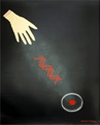Science, Art, Litt, Science based Art & Science Communication
When you think of DNA structure, you visualize only a double helix. Don't you? Like this one...

Art work by Dr. Krishna Kumari Challa
A conventional strand of DNA is made up of “base pairings”. The building blocks of the double helix are substances called bases – adenine, thymine, cytosine and guanine. Generally speaking, the structure of the molecule comes from adenine binding with thymine and cytosine binding with guanine, but this is not the case with the i-motif.
But now a new DNA structure inside human cells known as the “i-motif”, has been identified by scientists. The i-motif is a four-stranded ‘knot’ of DNA.
This form resembles a twisted “knot” of DNA, instead of the well-known double helix first described by James Watson and Francis Crick.
A new study published on April 23 rd 2018 in the journal Nature Chemistry provides the first direct evidence that it does exist and that it may play an important role in regulating our genes.
Earlier work has previously suggested the existence of DNA in this form, but this is the first time it has been observed in living cells. While i-motifs have previously been observed under artificial conditions in laboratories, prior to this work it was unclear whether they existed in living cells.
To spot the i-motifs, teh researchers designed an antibody — a protein that targets foreign invaders in the body — to specifically find and latch onto i-motifs. They tagged these antibodies with a fluorescent dye and then injected them into human cells in the lab. Using powerful microscopes, they spotted a bunch of tiny, glowing, green dots — colored antibodies holding onto elusive i-motifs.
The hardest part about publishing this paper was proving that the antibody latched only onto i-motifs and not onto other shapes of DNA. They did this by testing how the antibody interacted with other forms of DNA, such as the classic double helix and a better-studied structure related to the i-motif, called the G4 quadruplex. The antibody proved faithful — it didn't bind to either of these other forms.
Not only that these i-motifs existed in living cells but that these green lights twinkled on and off — meaning the i-motifs folded into existence and then unfurled, repeatedly. In particular, the researchers found that the DNA folded into i-motifs at higher rates during a specific stage of transcription — the process that kicks off the translation of genes into proteins — when the DNA was just beginning to actively transcribe. Later, the DNA unfolded back into its usual form, and the i-motifs disappeared. According to the researchers, this probably means the i-motifs play a very specific role in regulating the transcription process.
This study supports previous research in lab dishes that these folds occur in areas that regulate genes. These areas include the very ends of chromosomes called 'telomeres' that are thought to play a role in aging and regions called promoters which are tasked with turning genes on and off.
But despite knowing some of the regions in which these folds can appear, the researchers don't yet know which genes the folds control or what happens when you disturb the cell so that it can't form these structures.
Seeing DNA folded like this in living cells "makes it possible to decode those parts of the genome and understand what they do."
Indeed, these weird folds are probably present in every one of our cells, the scientists said. And because the genome has fewer folds like this compared with regularly shaped DNA, drugs that target DNA may be able to bind more specifically, compared with non-folded regions, they said.
These types of drugs could be helpful for cancer treatment, for example. One problem with certain cancer treatments is that they aren't selective enough in targeting the problematic stretches of DNA. Instead, cancer drugs may attach to other parts of DNA as well, leading to possibly harmful side effects.
This new discovery provides a firm foundation for a major therapeutic effort around these new structures.
Views: 153
Replies to This Discussion
-
63
-
© 2024 Created by Dr. Krishna Kumari Challa.
Powered by
![]()